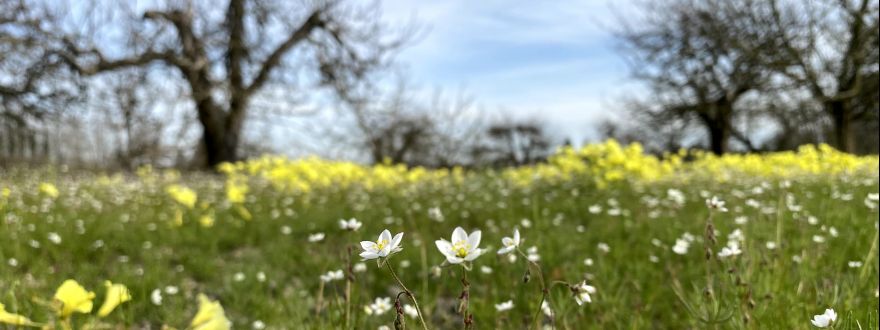
A bone-dry February is about to go into the local record books, punctuating the rising unease among residents and fire officials over the specter of renewed drought and an early fire season that could lead to calamitous conditions come fall. No measurable rain has fallen — or is expected — this month in Sonoma County, marking the first time in more than a century that February has delivered zero precipitation in Santa Rosa, where records go back to 1902. Since this month, the most arid February on the books was in 1953, with a mere 0.08 inch of rain in the city. The last time any measurable rain came down in Sonoma County was Jan. 28, when 0.03 was reported. “Just enough to wet the ground,” said National Weather Service meteorologist Steve Anderson.
And that moisture is long gone, with a string of unseasonably warm, clear days over the past two weeks ushering in an early glimpse of spring, including bud break on local vineyards and fields of blossoming wildflowers in the hills. Santa Rosa hit 81 degrees Tuesday, setting a new record for Feb. 25. The winter storm door isn’t entirely shut. March can deliver megastorms — in dry years they are hailed as “March Miracles” — yet the prospects for one of those turnarounds don’t look good, authorities said.“We are still in the ‘window’ for a miracle spring but every dry week that passes decreases the odds of that happening,” said Jay Jasperse, chief engineer at Sonoma Water, the agency that supplies Russian River water to 600,000 Sonoma and Marin county residents.
Santa Rosa has received 15.82 i nches of rain since Oct. 1, about two-thirds the seasonal average for this time of year. Little more than 2 inches has fallen since January. Blame for the dry patch rests with a high pressure ridge that has been shunting storms north into Canada. It could relent the weekend of March 7, but “the jury is still out” on whether it brings rain, said Ryan Walbrun, a National Weather Service meteorologist. A slight chance of rain exists for Sunday, he said. But “widespread beneficial rainfall is not anticipated at this time,” the weather service said Tuesday.
The parched outlook comes in what is typically one of the wettest months, when the Russian River is known to spill its banks and inundate towns for days. This week marks the one-year anniversary of a multi-day storm that caused the worst flooding on the river in nearly 25 years, coming up just shy of the historic Valentine’s Day flood of 1986, which caused widespread damage in and around Guerneville. By contrast, the river’s flow Tuesday at Hacienda bridge near town was less than one-tenth of the 80-year average for this time of year.
A dry winter means brush and timber that provide “heavy fuel” for wildfires are deprived of the usual seasonal soaking and prematurely become ready burn, said Paul Lowenthal, Santa Rosa’s fire marshal. “It’s happened before,” he said. “It’s something we have to start thinking about if we don’t break the pattern.”
Santa Rosa’s zone of greatest wildfire risk — no secret for longtime residents or even newcomers within the past few years — is now documented in a map. It shows the sprawling area west of the Mayacamas Mountains, taking in the city’s northeast shoulder. The zone, located northeast of Skyhawk, lies between the footprints of the Tubbs and Nuns fires of 2017. “We are behind the curve (on rain) and getting farther behind each day with no rain,” said Ben Nicholls, a Cal Fire division chief based in Santa Rosa. If March — a month that averages nearly 5 inches of rain — remains fairly dry, fire season could start in April or May instead of June, the usual beginning, Nicholls and Lowenthal said. “We don’t want to start early and then have a long, dry summer ahead of us,” Nicholls said.
There have already been 281 wildfires in California this year, including 87 in the past week, covering 200 acres, Cal Fire reported. At the same time last year, the agency had handled 91 fires scorching 78 acres. The average for the period is 246 fires burning 1,546 acres. The U.S. Drought Monitor last week classified 60% of California as “abnormally dry,” including nearly all of Northern California, with a small segment in “moderate drought.” “The short-term conditions (on nonirrigated land and nonmanaged rivers) look bad, but reservoirs are fine,” said David Miskus, a meteorologist with the federal Climate Prediction Center.
At the beginning of February, just 34% of the state was in a drought condition. Due mostly to heavy rainfall last year, Northern California’s three largest reservoirs — Shasta, Oroville and Trinity lakes — are at or above their historic average for this time of year. Lake Sonoma near Healdsburg, the largest reservoir in the Russian River system, is more than 90% full. Sonoma Water officials are especially pleased, despite the rain-scarce year, that Lake Mendocino is about 16% above its designated capacity due to an effort to improve coordination of storm forecasting and flood releases.
Forecasts currently show no major storm activity for the Russian River area for the next week, said Marty Ralph, director of the Center for Western Weather and Water Extremes at the Scripps Institution of Oceanography, which established the program. “Slight uptick of chances the following week,” he said in an email.
You can find this article in its natural habitat here, thanks to the Press Democrat.





